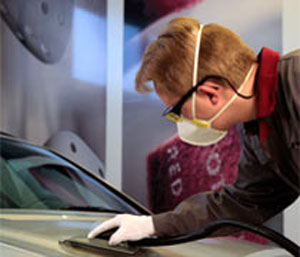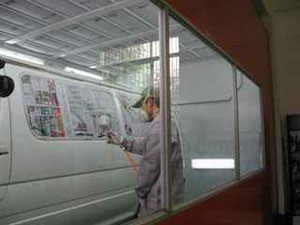Automotive Refinisher
Tasks & duties

Automotive refinishers may do some or all of the following:
-
discuss vehicle painting options with customers or managers
-
remove wax, grease and dust from vehicles before painting
-
cover the parts of the vehicle that are not to be painted
-
apply primer over repairs
-
find the right colour to apply to the vehicle body
-
mix the paint to make the right colour
-
sand the vehicle during the painting process
-
apply the paint
-
apply blending thinners to any dry edges
-
set the oven to dry the paint
-
buff and polish the finished paintwork
-
ensure hazardous waste is disposed of appropriately
-
paint plastic bumpers
Skills & knowledge

Automotive refinishers need to have:
-
knowledge of how to prepare a vehicle for painting
-
knowledge of vehicle painting techniques
-
knowledge of paint types and colours
-
knowledge of effective use of colours and texture
-
colour-matching and spray-painting skills
-
good communication and listening skills
-
skill in making calculations
Entry requirements
To become an automotive refinisher you need to complete an apprenticeship and gain a National Certificate in Automotive Refinishing. For further information about apprenticeships contact the New Zealand Motor Industry Training Organisation (MITO).
Automotive refinishing apprenticeships are part of the Modern Apprenticeship Scheme, which are for people aged 16 to 21. For further information go to the Modern Apprenticeships website.
Secondary education
Many employers prefer apprentice automotive refinishers to have three years of secondary education. Useful subjects include English and maths.
Students can also take part in a secondary school automotive training programme called Startup, which is run by MITO and provides a pathway for students into the automotive industry. The programme includes both theory and practical components so students can gain NCEA credits as well as practical work experience. For further information contact the New Zealand Motor Industry Training Organisation (MITO).
Tertiary education
It is an advantage to have completed a National Certificate for Entry to Motor Body Trades before beginning an apprenticeship.
Training on the job
Automotive refinishers can attend courses on new products and how to use them.
Useful experience
Useful experience includes working in an automotive workshop or in panelbeating. Work as a signwriter or industrial spray-painter may also be useful.
Video
From just a job on you tube
Related courses
Automotive Engineering
Automotive Vehicle Refinishing
Panel Beating
For more information, please refer to Career Services.
Document Actions
